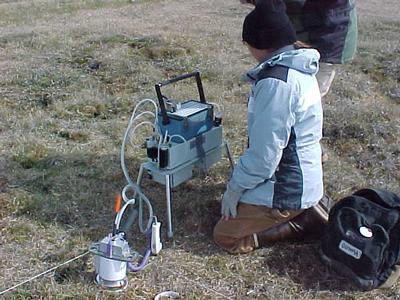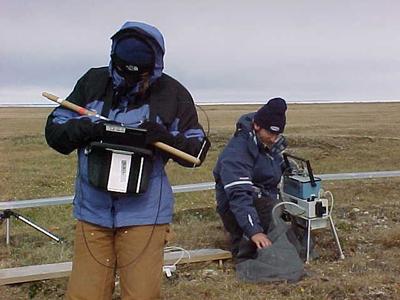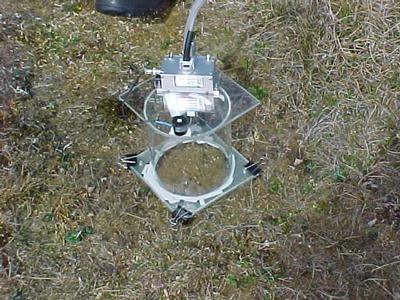7 July, 2001
Saturday
We awoke to a gray sky and snow flurries falling, all day. Two good
things about that; little to no wind and no mosquitoes! After lunch we
had alot of things to do in the field. We went out and spent all
afternoon on various projects.
Lety is studying soil respiration. She has set up her study areas (8
plots) this past week and began taking measurements today. When studying
carbon dioxide flux there are two processes where carbon dioxide is
exchanged from air to plants and vise versa . First in the process of
photosynthesis, which we normally think of as the daytime growing process
when plants take in CO2 and act as "sinks". The second CO2 exchange
takes place in darkness, when the plants go through the process of
respiration, the giving off of CO2 to the atmosphere. During the latter,
the plant's vascular, aboveground parts and the plant's below ground
parts, the roots, give off CO2. In the arctic, where 95% of an entire
plant may exist below ground in its root system, measuring soil
respiration is important when calculating the carbon budget of the
ecosystem.
Lety has isolated two areas per plot and defined them using two 4inch
round PVC pipe sections placed in the soil to a depth of approximately 2
inches. One circle she placed over undisturbed plants and in the other
she has removed the above soil, plant parts. Using the LiCor, which we
use during diurnals, she covers the PVC sections with a "mini cuvette"
(pictured below) and measures the CO2 each circular area gives off. The
carbon dioxide comes from a number of sources: respiration of roots,
decay of organic matter and the activity of microbes. The amount of
moisture in the soil also is important when measuring CO2 in the soil.
Empty pore spaces can contain gases. When soil moisture is high the pore
spaces are filled with water, displacing the gas. Soil respiration is
very dependent on soil temperature, organic matter, moisture content and
precipitation.
The picture below shows Lety taking measurements with the small white
chamber (LI 6000, soil respiration chamber). One important thing she also
has to do is account for the CO2 in the chamber when placing it on the
sample. She does this by running the pump and scrubbing the existing CO2
out of the closed system before taking a measurement.
Lety recorded her first round of measurement s today and made it to all
the 8 plots in 2 hours. She will take 3 measurements at each in the
next few days but now she wants to check the data she is generating
against Glen's first to see if things are working correctly. The numbers
she will get will not be the same as Glen's numbers but should be somewhat
similar. It's always convenient to have something or someone to compare
to when you are initially taking measurements.
Finding out soil respiration is important for understanding where the
carbon is coming from and whether the processes you are studying are a net
source or sink for the carbon in the atmosphere.
Glen also was gathering data at his site today using the LiCor to compare
his control plots with the heated plots to see what effects the treatments
were having on the carbon fluxes. Along with them were Stan and Erika
taking LiCor measurements at the CA. State LA site. They are measuring
species-specific fluxes. So every one was measuring fluxes of one sort
or another all afternoon.

Lety and Glen setting up the LiCor at the first of her 8 sites. Below Lety is kneeling while the soil respiration chamber is taking measurements. You can see the two PVC casings. The white handled instrument sticking into the soil, outside the string, is a temperature probe.

Lety measuring soil respiration.

Erika and Stan measuring species-specific carbon flux. Stan is using the LiCor while Erika is measuring reflectance of the plants.

Stan is using a "mini" cuvette built by John Gamon. Many pieces of equiptment have to be custom made by the scientists doing
Contact the TEA in the field at
.
If you cannot connect through your browser, copy the
TEA's e-mail address in the "To:" line of
your favorite e-mail package.
|
